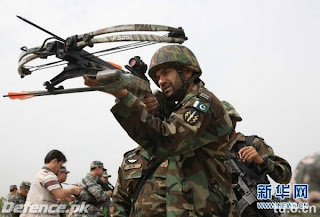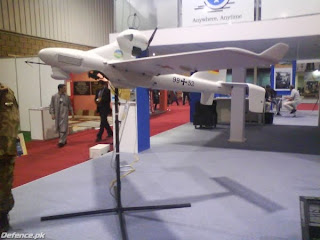LINTHICUM, Md: Northrop Grumman Corporation, in conjunction with the U.S. Air Force, has successfully completed a series of demonstration flights of its Scalable Agile Beam Radar (SABR) installed in an F-16 fighter aircraft at Edwards Air Force Base,Calif. The demonstration was in support of a U.S. Air Force F-16Active Electronically Scanned Array (AESA) feasibility study.
"Almost two years ago Northrop Grumman said that air forces of the future will necessarily gravitate toward using AESA technology “especially through scalableretrofit technology. Our team has worked diligently to make thatpossible and today we've made it a reality. This officially marks thefirst time a retrofit AESA has ever flown in a legacy F-16," saidArlene Camp, director of Advanced F-16 Radar Programs at NorthropGrumman's Electronic Systems sector.
"This demonstration validated our goal of developing an AESA that can be easily installed on the flight lineand integrated with existing power and cooling provisions of currentlyfielded F-16s," Camp added. "With regard to installed performance,SABR's air-to-air and air-to-ground detection and tracking andSynthetic Aperture Radar (SAR) mapping performance met or exceeded ourpredictions."
SABR is an affordable and scalable AESA radar designed for retrofit in current F-16s and other legacy fighter, attack, and trainingaircraft. Compared to mechanically-scanned array radars, SABR willprovide the increased performance, multi-functionality, and greaterreliability inherent in AESA radars. In terms of combat capability,SABR provides improved situational awareness, greater detection,high-resolution SAR maps, interleaved air-to-air and air-to-surfacemode operations, and an all-environment precision strike capability.
Northrop Grumman has been the sole provider of radars for the F-16and for over 30 years has continually improved the F-16 radar'sperformance and reliability. More than 5,000 F-16 radars have beenproduced for the U.S. Air Force and 24 nations worldwide.
Because of this extensive foundation and rich F-16 heritage andplatform intimacy, Northrop Grumman is the first to design, develop,integrate, test and successfully demonstrate retrofit AESA capabilityin flight on a legacy F-16. SABR is part of Northrop Grumman's robustproduct family of multi-function sensors and capabilities.
Northrop Grumman Corporation is a leading global security companywhose 120,000 employees provide innovative systems, products, andsolutions in aerospace, electronics, information systems, shipbuildingand technical services to government and commercial customersworldwide.
Search
Followers
Tag Cloud
- ABM (7)
- Abu Dhabi (1)
- Aero-India-2011 (15)
- Afghanistan (5)
- Air defence System (4)
- Arjun Tank (6)
- Armoured Vehicles (10)
- Artillery (11)
- ASIA (1)
- Austrailia (3)
- AWACS (8)
- Ballistic Missile (1)
- Bangladesh (4)
- C-130 (2)
- china (173)
- CHINA-PAKISTAN-NUCLEAR-DEAL (1)
- CIA (1)
- Cobra heli (1)
- Cruise Missile (3)
- Cruise Missiles (2)
- Dubai Air Show (2)
- EF-2000 TYPHOON (8)
- European Union (4)
- F-16 (16)
- F-18 (6)
- F-22 (8)
- F-35 (18)
- FC-20 (6)
- Fighter Jet (151)
- France (15)
- Frigate (4)
- Germany (1)
- HAL-Dhruv (1)
- Helicopter (23)
- IDEAS DEFENCES SHOW (2)
- IDEF-2009 (1)
- IDEX (1)
- IL-78 (1)
- INDIA (196)
- Indonesia (3)
- Irag (2)
- Iran (27)
- Israel (14)
- J-10 (12)
- J-11 (1)
- J-16 (1)
- J-20 J-XX Chinese Stealth Fighter (16)
- J-20 J-XX fChinese Stealth Fighter (3)
- J-xx (7)
- Japan (5)
- JAS-39-Gripen (12)
- JF-17 (17)
- K-8 (2)
- L-15 (2)
- Laser_Weaponry (1)
- LCA (8)
- LCH (1)
- Malayasia (1)
- Martime Patrol Aircraft (2)
- MCA (2)
- Middle East (4)
- Mig-29 (1)
- Mig-35 (3)
- Missiles (51)
- Missiles Boat (1)
- MRCA (4)
- MRLS (1)
- NATO (1)
- NAVAL (61)
- North Korea (4)
- Nuclear (9)
- Nuclear Submarine (1)
- P-8i (2)
- PAC-3 (1)
- PAF (1)
- Pak-FA (15)
- Pakistan (87)
- Radar (30)
- Rafale (7)
- Rokestan (1)
- Russia (82)
- S-400 (1)
- Saudi Arabia (2)
- Sayria (5)
- Singapore (2)
- South korea (7)
- Space (3)
- Special-Reports (20)
- Sri Lanka (4)
- Stealth-Fighter (1)
- Su-27-30-35 (19)
- Submarine (21)
- Taiwan (11)
- Tank-MBT (18)
- Tanker Aircraft (2)
- Training Aircraft (3)
- Transport Aircraft (6)
- Turkey (25)
- UAE (3)
- UAV (32)
- UCAV (1)
- USA (73)
- Z-10 (3)
Popular Posts
-
The Indian Ministry of Defence has issued a tender for the import of 66,000 5.56 mm assault rifle for an estimated $250 million (Rs 13...
-
A German team is due in few days probably on August 5th according tosources to look into possibility of signing the accord for provision ofU...
-
China agree to give J-20/FC-20 5th Generation Stealth Fighter to Pakistan" Defence Minister Ahmad Mukhtar said. The J-20 is a singl...
-
U.S. plans for a missile defense system in Europe will pose a genuine threat to Russia's nuclear deterrence capability if they are ca...
-
On the 63rd Independence day Master Abdul Basit a 15 year old boy madea history to become soldier of Pakistan Army for a day. The young,patr...
-
India's state-owned Defence Research and Development Organization (DRDO) claims that it has completed upgrades on the Arjun tank, replac...
-
St. Petersburg's Severnaya Verf shipyard on Thursday started construction of a new corvette for The Russian Navy. The project 20385 c...
-
The cost of building the F-35 fighter jet, set to replace a large part of the US warplane fleet, is "unaffordable" in its curre...
Feedjit
Pakistan Military Watch Archieves
-
▼
2010
(512)
-
▼
July
(33)
- Scalable Agile Beam Radar (SABR) Tested Aboard USA...
- E-8C Joint STARS Battle Management Role Recognized
- The Berlin Air Show marks 100th anniversary
- Boeing to acquire Narus cyber security firm
- India-US begin price negotiations on Boeing C-17 a...
- PAK ARMY And CHINESE ARMY EXERCISE PICS
- JF-17 Pics
- IDEAS 2008 Pics
- J-10 Pics
- Initial Delivery of Wedgetail Aircraft
- South Korea Accepts the First Arthur WLR System
- New AN/TPQ-46B Radar Delivered to US Marines
- Northrop Highlights Global Security Capabilities a...
- Raytheon Eyes International Contract Award for its...
- Radar Still a Lucrative Market, Despite Economic Woes
- USAF Officials Launch Digital Airport Surveillance...
- Advanced Radar Improves Iraqi Air Surveillance
- Production Begins on New Radar for B-2 Bomber
- Baykar Makina Caldiran Tactical UAV's
- Baykar Malazgirt Mini Helicopter UAV
- Turkish Aviation Programs-Tiha Male UAV Block-A
- DoD Adviser: Foes' Advances Might Lead to F-35 Fle...
- PAF's possible answer to MRCA
- Pakistan plans to buy 14 more F-16 jets from USA
- Pentagon pitches for $10 billion Indian fighter je...
- US offers top of the shelf weapon systems to India
- Choosing French Submarines over German?
- Pak Army commandos leave for China for weeklong dr...
- DRDO designing advanced version of Arjun MBTs for ...
- J-10
- Army reworks war doctrine for Pakistan, China
- Pakistan receives first AWACS aircraft
- PAF attains Night time attack capability: PAF Chief
-
▼
July
(33)

































































